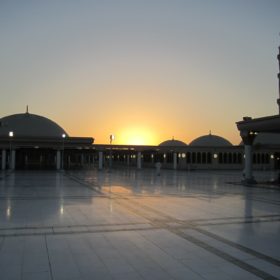Saudi Arabia reveals bidders for 3.7 GW solar tender
Saudi Power Procurement Co. (SPPC) has announced the selected bidders for the the fifth round of the Saudi Arabian government’s renewable energy tender program.
Monocrystalline solar modules more resistant to hail than polycrystalline panels
Scientists from Pakistan, Qatar and Saudi Arabia have conceived a new experimental setup to conduct hail impact tests for photovoltaic modules. The first tests showed that monocrystalline panels lose less efficiency than their polycrystalline counterparts with the same number of busbars.
New CIGS solar cell design with antimony trisulfide promises 31.15% efficiency
The novel solar cell uses antimony trisulfide (Sb2S3) as the back surface field (BSF) layer. According to its creators, this layer can be included in conventional CIGS solar cells to improve their efficiency and reduce the absorber material’s cost.
Key takeaways from SunRise Arabia conference
Saudi Arabia has laid out an ambitious vision to establish itself as a renewable energy hub for the Middle East and beyond. The market is growing rapidly, with solar generation capacity more than tripling in 2023. But obstacles remain for the Kingdom to continue on this PV pathway, and these challenges were up for discussion this week in Riyadh at the SunRise Arabia conference, organized by Solarabic and pv magazine.
New anti-reflective coating for silicon solar cells
Developed by an international research group, the novel anti-reflective coating is based on silicon dioxide and zirconium dioxide. It reportedly minimizes a solar cell’s reflection loss, while enhancing its light absorption properties.
PV may help CSP reduce its LCOE by 18% in Saudi Arabia
Researchers have found that the current levelized cost of energy (LCOE) for concentrated solar power (CPS) plant in Saudi Arabia could be as low as $0.137/kWh. However, combining the tech with PV would significantly enhance the cost competitiveness of CSP.
Smart grids could improve Saudi Arabia’s renewables potential
Saudi researchers say smart grids could have a minimal impact on the environment in Saudi Arabia, while supporting a technologically advanced power system compatible with end users.
Saudi Arabia identifies 1,200 sites for wind, solar projects
The Saudi energy minister, Abdulaziz bin Salman Al Saud, says a team of experts have conducted a geographic survey to identify 1,200 sites for wind and solar projects across Saudi Arabia.
Radiative cooling tech for vertical solar panels
Developed by a US-Saudi research group, the novel technique employs two 45-degree inclined mirrors on the two sides of a PV module. On the back side, a spectral selective reflector enables the thermal radiation to be directed to the sky while preventing the back of a module from heating up by the scattered sunlight.
Perovskite-silicon tandem solar cell with sublimed C60 source material achieves 30.9% efficiency
The result was certified by Fraunhofer ISE CalLab. The cell uses a top inverted PV device using an electron transport layer made of thermally evaporated buckminsterfullerene (C60) with minimized parasitic optical absorption.










